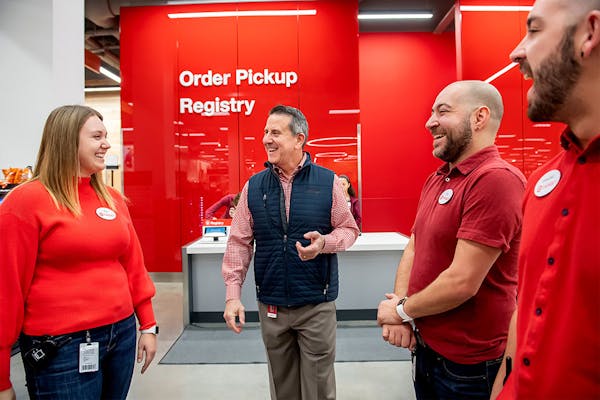A surprising leap in clothing sales and a sharp increase in use of its same-day delivery and pickup options helped boost Target's sales and profits higher than expected, sending its shares up 14% to an all-time high.
Target stock, which has risen more than 90% this year, closed Wednesday at $126 a share.
The strong results, which included a 4.5% jump in comparable sales from August to October, gave investors even more confidence about Target heading into the important holiday shopping season.
"They're executing at the top of their game," said Brian Yarbrough, an analyst with Edward Jones. "They're operating as one of the better-run retailers in the universe."
Target's third-quarter results showed that its investments in new brands and faster delivery seem to be paying off at a time when other retailers, such as department stores, continue to struggle.
Most notably, Target said apparel sales, which have been fairly soft industrywide, rose more than 10% in the quarter. The growth was also a major factor in increasing Target's bottom line since clothing has higher profit margins compared with products such as toys and electronics. Executives noted Target also sold more apparel at regular price during the quarter without having to discount it.
CEO Brian Cornell told analysts on a conference call that women's, sleepwear, intimates, jewelry and shoes were especially strong categories in apparel during the third quarter. He added that the growth came from Target's newer private-label brands as well as from some of its more recent partnerships with brands like Levi's.
"It's a great example of how our strategy has come together where we remodeled stores and create an inspiring in-store environment," he said. "We surround our guests with exceptionally well-trained team members. We're providing on-trend styles at a great value, and we're providing a similar experience online."
Cornell told reporters that it is hard to know exactly which retailers Target is taking market share from.
"But we know we're gaining significant share within the apparel category," he said. "We're picking it up from a number of competitors whether it's department stores or specialty."
Most of Target's sales growth in the quarter came from its stores. Besides the remodels, Target has been attracting new shoppers as it opens about 30 new stores a year in urban areas and near college campuses.
"We're moving into new neighborhoods," Cornell said. "Those were guests that were not shopping Target on a regular basis before. They are now."
Target's digital sales grew 31% in the quarter, with the bulk coming from its in-store pickup, curbside and delivery through Shipt services.
"The growth rate of all three of these services in 2019 has been nothing short of remarkable," said John Mulligan, Target's chief operating officer.
While Target has offered "buy online, pick up in store" for five years now, it still grew 50% in the quarter, he said. But its biggest growth came from Drive Up, which grew fivefold, in part because Target has rolled out the service to 800 more stores since the same time last year. And same-day delivery through Shipt more than doubled, Mulligan said.
These services, which are more profitable for Target than shipping items, also helped Target improve its profitability. And Mulligan noted they are expected to be an even bigger factor during the holidays.
"This year, with six fewer days between Thanksgiving and Christmas, our guests may find themselves with less time than usual," he said. "These are times our same-day services can feel like a lifesaver."
On Wednesday, Target also lifted its annual profit outlook after reporting a 14.8% increase in third-quarter profits to $714 million. When adjusted for one-time items, it earned $1.36 a share, much higher than the $1.19 a share analysts had forecast.
Target's overall revenue also topped analysts' expectations at $18.7 billion.
"Another excellent set of results from Target underlines the fact there is growth available in the consumer economy and that those retailers which inspire and engage customers can grab a slice of it," Neil Saunders, an analyst with GlobalData Retail, said in a statement. "That said, Target has also outperformed the overall retail sector over the third-quarter period, showing that it is taking market share from rivals."
For the fourth quarter, which includes the important holiday-shopping season, Target said it expects comparable sales growth of 3% to 4%, which is roughly in line with industry forecasts for holiday sales growth.
In the past few months, Target has announced new partnerships, including one with Disney to open interactive minishops in 25 of its stores this year followed by another 40 next year.
It has also started powering the website of a scaled-down and revised Toys 'R' Us, which is trying to make a comeback online. Under new leadership, Toys 'R' Us is also opening two small mall-based stores this month after closing all of its big-box stores last year following a bankruptcy. When shoppers want to buy an item on Toysrus.com, they are now redirected to Target's website to make the purchase.
Target's chief merchandising officer for the last three years, Mark Tritton, also left the retailer last month to become CEO of Bed Bath & Beyond. The company has said it will not immediately replace him but instead will split the role between two current merchandising executives.
Kavita Kumar • 612-673-4113
